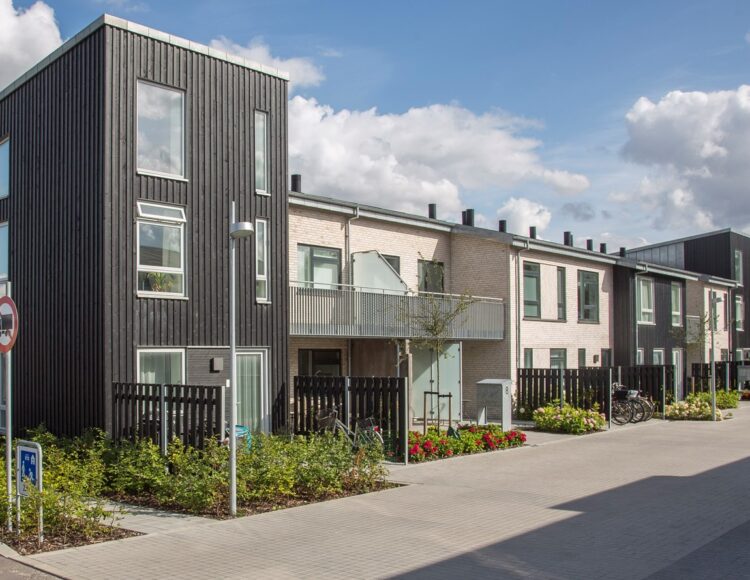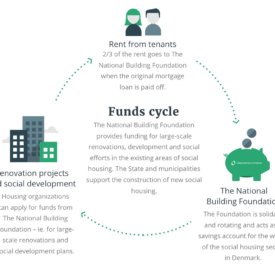For more than 50 years, the National Building Fund has been playing a crucial role in supporting the Danish social and affordable housing sector, ensuring that housing providers are not affected by pro-cyclical investments, usually peaking during times of the strongest economic prosperity and declining in times of economic difficulty. Instead, the Fund allows social and affordable housing operators to be self-funded not needing to rely on public financing only. Housing Europe’s Social Affairs Chair, Natalia Rogaczewska and Solveig Råberg Tingey, a Chief Economist at the Danish Federation of Non-Profit Housing Providers (BL) explain how does this system work in practice.
A good place to live is one of the most important conditions for creating a good life.
A well-functioning society needs decent housing for everyone regardless of income and social status. Over the last century, Danish social and affordable housing has played an essential role in Denmark providing housing for families and individuals– adding value to society and improving living standards.
In Denmark social housing is called social because it is a central part of the Danish welfare society. It is non-profit and universal in order to maintain a wide-spectrum social mix of tenants to the benefit of the individual and society. Its main purpose is to deliver affordable housing for all in need.
Today almost 1 million people in Denmark lives in the social and affordable housing sector corresponding to one in every six people and 600.000 housing units.
The National Building fund is a cornerstone in the Danish affordable and social housing model ensuring a high standard of the existing housing stock and a better life-quality and well-being of tenants.
High sense of solidarity
The National Building Fund was founded in 1967 through a broad political agreement. Its main purpose was – and still is – to function as a solidarity fund for the social and affordable housing sector.
The National Building Fund is used to balance surpluses with deficits across all the housing estates using the fund as an equalization mechanism. This ensures a fiscally solid sector and allows most capital and operating funds for social and affordable housing to be self-funded not needing to rely on public financing.
A private tenant savings fund
The National Building Fund is a private fund that is financed solely by the 1 million tenants in the sector. The fund is solidary and circular and acts as a savings account for the entire affordable and social housing sector.
The initial capital was built on contributions from a gradual rent increase in the sector determined in a political agreement in 1966.
The National Building Fund is thus regulated by law but financed by tenants.
Today capital arises through compulsory contributions from tenants of housing estates established before 1970 and through payments collected after mortgage loans that are established to finance new build of estates are repaid. Mortgages are taken on normal market terms.
In the coming years in increasing part of the mortgages will be paid off. This will enhance access to capital in the fund and allow it to play a larger part in social and affordable housing developments economically, environmentally, and socially.
Supporting sustainable affordable housing developments
The National Building Fund finances the expansion of new social and affordable housing and renovation work of existing properties. This includes improvements of inside and outdoor areas, modernization of
buildings to include access for elderly and disabled people and energy improvements. The fund can also cover demolition costs and support infrastructural changes.
A particular focus is investments in social activities and rental price reductions. The purpose is to build socially cohesive, safe, and sustainable communities. The efforts are organized in local partnerships (school, municipality, NGO’s etc.) with the aim to promote among other employment opportunities and educational performance among tenants.
Support from the fund is obtained through applications submitted by the housing organizations and allocated by objective criteria. However, the areas of investments and amount of funding is set in political agreements made every 4-6 years by the Danish Parliament.
Funding is also an economic recovery
Over time, the state has used the National Building Fund to increase growth during recession by allowing more funding for renovation work – creating more jobs in the construction and service sector.
This also happened in 2020 where a political agreement across Parliament allocated 30 billion DKK from the National Building Fund to a renovation scheme of social and affordable housing in 2020-2026 in order to support a socially balanced green transition of the existing housing stock. Of these, 18.4 billion DKK (2.4 billion €) will be used to initiate renovation of 72,000 units before end 2021 that were already in queue for support from the fund. The remaining 11.6 billion DKK (1.5 billion €) are allocated to future renovations until 2026.
The renovation scheme is expected to create increased employment needed due to the economic slow-down created by the COVID19 pandemic.
On top of that renovations create 30-40 pct. less energy consumption as well as indoor health care benefits for the tenants. And because renovations are supported by the fund, rents are kept affordable.
What’s not to like?
Learn more about the Danish social and affordable housing sector and the National Building fund.

